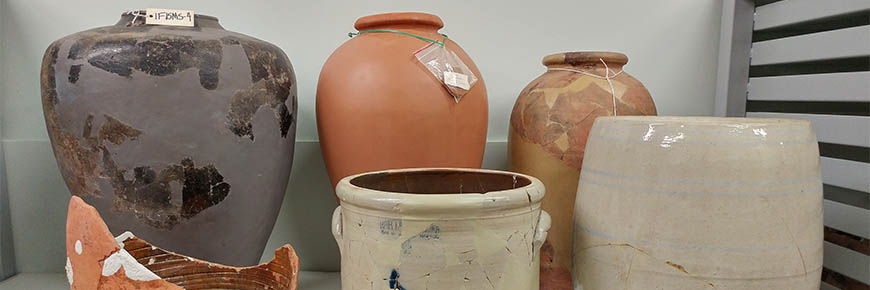
Old meets new: Parks Canada’s national collection gets a new home
Did you know?
Together under one roof
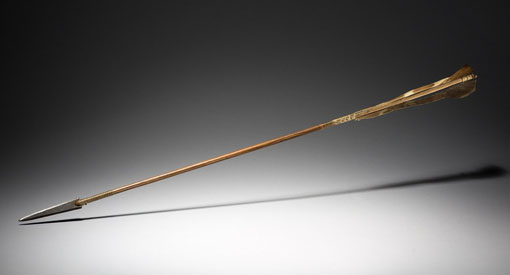
Indigenous arrow gifted to Major Walsh in the 1800s. Currently on display at Fort Walsh National Historic Site in Saskatchewan.
The national collection is an integral part of interpretation, exhibits, and other programming used to share the stories of Parks Canada’s national historic sites, national parks, and national marine conservation areas with visitors.
Parks Canada currently manages and operates six collection storage facilities located in five cities - Winnipeg, Cornwall, Ottawa, Quebec City, and Dartmouth - and work is underway to move the objects in these facilities to a new purpose-built collections facility in Gatineau, Quebec.
Why a new building?
Excluding Dartmouth, the existing storage facilities do not meet environmental and security standards. As a result, approximately 60 percent of the 31 million objects under Parks Canada’s care are under threat due to inappropriate environmental storage conditions and lack of appropriate security.
Upon consolidation, the collection will be stored in the Gatineau facility specifically designed for collections preservation and managed by a national team of curatorial, collections and conservation specialists.
The Dartmouth collections facility in Nova Scotia is the only building where artifacts will continue to be housed as it meets the required conservation and security standards.
Building design and construction
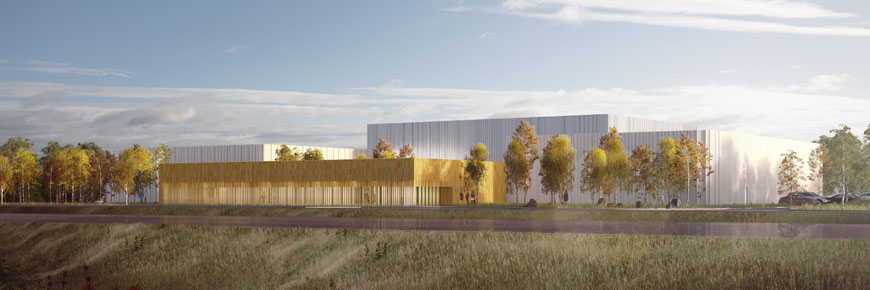
Exterior design of new purpose-built collection storage facility. © Moriyama and Teshima Architects and NFOE Architects, in joint venture.
The 8,200 m2 facility will ensure that the collection under Parks Canada’s care is conserved and cared for over the long-term in a sustainable manner for the benefit of current and future generations. To facilitate access to the collection, approximately 1,350 m2 has been dedicated to workspace for researchers and staff, and spaces for reception, meeting, and ceremonial use.
Construction activity is underway and completion is expected in 2023.
Key building features
Optimal environmental and storage conditions to safeguard the collection
- Class A climate control with rigorous temperature and humidity set points.
- Double wall construction around the collection storage area for additional insulation, to maintain required temperature and humidity requirements, and to protect the collection from external threats, such as pests.
- Heating, ventilation, and air conditioning systems that are on emergency generators, to ensure consistent climate control in the event of a power outage.
- A storage system that maximizes space and provides flexible storage capacity to facilitate access and retrieval, and to account for changes in the collection over time.
Dedicated spaces to facilitate access to the collection for all Canadians, including Indigenous peoples, researchers, institutions, and community groups
- Access to the collection, as a whole, in one location.
- Collaborative workspaces to access and view objects and related documentation.
- Dedicated reception, meeting, and ceremonial spaces, including special ventilation for ceremonies such as smudging, to accommodate visitors, events, and special gatherings.
- Dedicated packaging workshop, loading dock, and quarantine area to safely ship and receive objects.
Healthy and collaborative workspace for Parks Canada team members
- Office spaces with abundant daylight and superior indoor air quality.
- Flexible and collaborative work areas.
- Gender inclusive washroom facilities for staff, guests, and visitors.
Minimized environmental footprint through green building practices
- Adopting sustainable and energy-efficient green building standards, such as employing the use of recyclable materials, conserving water use, and workspaces with daylight and superior indoor air quality.
- Achieving a net zero carbon footprint by solely using renewable energy (hydroelectricity) to power operations.
- Adopting energy-efficient practices with the goal of reducing energy use to 30% less than the target stipulated in the National Energy code for buildings (NECB), resulting in significant energy cost savings.
- The use of native species in exterior landscaping and dry ponds to retain excess water from storms.
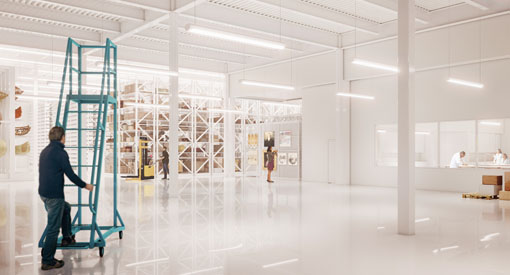
Optimal storage conditions. © Moriyama and Teshima Architects and NFOE Architects, in joint venture.
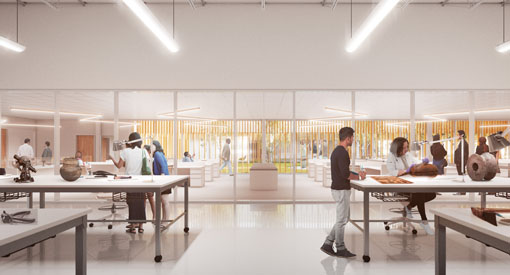
Dedicated researcher and staff workspace. © Moriyama and Teshima Architects and NFOE Architects, in joint venture.
Accessing the collection
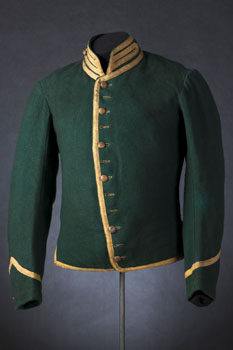
Historic jacket of the 19th century Fenians. Currently on display at Fort Wellington National Historic Site, Ontario
Parks Canada will continue to exhibit the collection under its care at Parks Canada places in every province and territory. Objects located in national parks and historic sites will remain in their present locations to share the stories of these fascinating places with visitors.
Parks Canada will continue to work with cultural and educational institutions to ensure that the collection remains accessible for research, educational, ceremonial and exhibit purposes. Coupled with Parks Canada's loans program, the same level of access to the collection will be maintained, if not enhanced.
Follow #OurVaults on Twitter to see a small sample of the archaeological and historical objects under Parks Canada’s care.
Frequently asked questions
What does Parks Canada’s artifact collection consist of?
Parks Canada cares for approximately 31 million historical and archaeological objects representing over 11,000 years of human history.
Historical objects in the collection have been acquired over the years to support interpretation, exhibits, and visitor experience at Parks Canada's national parks and historic sites. Examples of historical objects include furniture, costumes, textiles, and other everyday objects. These pieces are a mix of objects directly related to Parks Canada's historic sites and period antiques purchased to support visitor programming.
Archaeological objects in the collection are the product of archaeological work at Parks Canada's places and range from household goods and construction materials to pre-contact Indigenous hunting tools.
It is important to note that the majority of the archeological collection is fragmentary, consisting of items such as ceramic fragments, window glass shards, and nails. Artifacts such as these are not, for the most part, suitable for display but are an important historical record and of high interest to researchers and archaeologists in their study of Canada’s history.
Will Canadians continue to have access to the collection once it is consolidated?
Parks Canada will ensure that all interested parties have timely access to archaeological and historical objects.
Parks Canada will continue to work with cultural and educational institutions to ensure that the historical and archaeological objects in the collection remain accessible for research, educational, ceremonial, and exhibit purposes. Coupled with Parks Canada's active loans program, the same level of access to the collection will be maintained, if not enhanced.
In line with this commitment, Parks Canada’s new collection storage facility will include dedicated workspaces for researchers as well as meeting, event, and ceremonial spaces, including special ventilation for smudging ceremonies, to accommodate visitors, events, and special gatherings.
Consolidating the collection will allow all Canadians, including Indigenous peoples, researchers, institutions, and community groups from across the country to access the entire collection. Furthermore, having a collection that is properly stored, managed, and easily retrievable by a national team of collection specialists, curators and conservators, will increase Parks Canada’s ability to share the stories of these objects with Canadians through new and innovative ways such as travelling exhibitions and making the collection accessible for online viewing.
Will objects remain on display at Parks Canada places?
Absolutely. Parks Canada will continue to exhibit archaeological and historical objects at Parks Canada places in every province and territory to help connect visitors with the fascinating history of these places.
Objects currently displayed in national parks and historic sites, as well as objects on loan to partner organizations, will remain in these locations.
Are Indigenous peoples engaged in this project?
The Agency recognizes that Indigenous communities have a vested interest in the Indigenous objects and associated documentation in the collections, and is committed to working with interested Indigenous partners to arrive at solutions that support their interests.
To this end, Parks Canada continues to contact and engage Indigenous partners with an interest in the objects under Parks Canada’s care to further involve Indigenous peoples in the care and presentation of these objects.
What is so special about the new facility?
Parks Canada’s new purpose-built collection storage facility will have optimal storage and environmental conditions required to ensure the protection and conservation of the collection.
At the new facility, the collection will be cared for by a team of specialists, curators and conservators and will be properly managed, stored, and easily retrievable.
Consolidating the collection will allow Indigenous peoples, researchers, institutions, and community groups from across the country to access the entire collection. Archaeological and historical objects will be easily accessible for research, ceremonial, educational, and exhibit purposes. To support this, approximately 1,350 m2 of dedicated workspace for researchers and staff, as well as reception, meeting, and ceremonial spaces have been incorporated in the design.
In addition, the facility will have a reduced environmental footprint, by incorporating sustainable and energy-efficient green building practices and achieving zero carbon emissions through the use of renewable energy.
When is construction on the new purpose-built collection storage facility scheduled to begin and to end? When will the collection be moved?
Construction activity is underway and completion is expected in 2023. The collection will be relocated to the new facility in Gatineau once it is operational.
What is Parks Canada doing to prepare the collection for the move?
In advance of the move, Parks Canada is also undertaking a review of its collection. This review will allow the Agency to focus its resources on the objects that have heritage value and best enable Parks Canada to share our rich and varied history with Canadians. Doing so as part of the consolidation will also ensure that no unnecessary objects are moved to the new facility, reducing the cost to relocate the collection.
A collection review is a normal activity and a standard practice amongst museum and archeological institutions.
Parks Canada has and will continue to review its collection in order to maintain good collection management practices and ensure the responsible use of taxpayer dollars.
How do I stay up-to-date on the project?
Follow us on Facebook, Twitter, and Instagram for updates on this project! Check out #OurVaults to see a small sample of the archaeological and historical objects under Parks Canada’s care.
- Date modified :